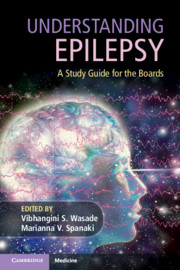Book contents
- Understanding Epilepsy
- Understanding Epilepsy
- Copyright page
- Dedication
- Contents
- Contributors
- Preface
- Chapter 1 Pathophysiology of Epilepsy
- Chapter 2 Physiologic Basis of Epileptic EEG Patterns
- Chapter 3 Pathology of the Epilepsies
- Chapter 4 Classifications of Seizures and Epilepsies
- Chapter 5 Electro-clinical Syndromes and Epilepsies in the Neonatal Period, Infancy, and Childhood
- Chapter 6 Familial Electro-clinical Syndromes and Epilepsies in Adolescence to Adulthood
- Chapter 7 Distinctive Constellations and Other Epilepsies
- Chapter 8 Seizures Not Diagnosed as Epilepsy
- Chapter 9 Nonepileptic Spells
- Chapter 10 Status Epilepticus
- Chapter 11 EEG Instrumentation and Basics
- Chapter 12 Interpreting the Normal Electroencephalogram of an Adult
- Chapter 13 Ictal and Interictal Epileptiform Electroencephalogram Patterns
- Chapter 14 Neonatal and Pediatric Electroencephalogram
- Chapter 15 Scalp Video-EEG Monitoring
- Chapter 16 Intracranial EEG Monitoring
- Chapter 17 Neuroimaging in Epilepsy
- Chapter 18 The Role of Neuropsychology in Epilepsy Surgery
- Chapter 19 Principles of Antiseizure Drug Management
- Chapter 20 Gender Issues in Epilepsy
- Chapter 21 Antiseizure Drugs
- Chapter 22 Surgical Therapies for Epilepsy
- Chapter 23 Stimulation Therapies for Epilepsy
- Chapter 24 Practical and Psychosocial Considerations in Epilepsy Management
- Chapter 25 Comorbidities with Epilepsy
- Chapter 26 System-Based Issues in Epilepsy
- Index
- References
Chapter 2 - Physiologic Basis of Epileptic EEG Patterns
Published online by Cambridge University Press: 11 October 2019
- Understanding Epilepsy
- Understanding Epilepsy
- Copyright page
- Dedication
- Contents
- Contributors
- Preface
- Chapter 1 Pathophysiology of Epilepsy
- Chapter 2 Physiologic Basis of Epileptic EEG Patterns
- Chapter 3 Pathology of the Epilepsies
- Chapter 4 Classifications of Seizures and Epilepsies
- Chapter 5 Electro-clinical Syndromes and Epilepsies in the Neonatal Period, Infancy, and Childhood
- Chapter 6 Familial Electro-clinical Syndromes and Epilepsies in Adolescence to Adulthood
- Chapter 7 Distinctive Constellations and Other Epilepsies
- Chapter 8 Seizures Not Diagnosed as Epilepsy
- Chapter 9 Nonepileptic Spells
- Chapter 10 Status Epilepticus
- Chapter 11 EEG Instrumentation and Basics
- Chapter 12 Interpreting the Normal Electroencephalogram of an Adult
- Chapter 13 Ictal and Interictal Epileptiform Electroencephalogram Patterns
- Chapter 14 Neonatal and Pediatric Electroencephalogram
- Chapter 15 Scalp Video-EEG Monitoring
- Chapter 16 Intracranial EEG Monitoring
- Chapter 17 Neuroimaging in Epilepsy
- Chapter 18 The Role of Neuropsychology in Epilepsy Surgery
- Chapter 19 Principles of Antiseizure Drug Management
- Chapter 20 Gender Issues in Epilepsy
- Chapter 21 Antiseizure Drugs
- Chapter 22 Surgical Therapies for Epilepsy
- Chapter 23 Stimulation Therapies for Epilepsy
- Chapter 24 Practical and Psychosocial Considerations in Epilepsy Management
- Chapter 25 Comorbidities with Epilepsy
- Chapter 26 System-Based Issues in Epilepsy
- Index
- References
Summary
Much of our attention as electroencephalographers is devoted to the identification and localization of spikes and seizures. Atlases, primers, and texts of electroencephalogram (EEG) interpretation provide a wealth of information to guide seizure identification, but often the diagnosis is based on the same principle as Justice Potter Stewart’s maxim for identifying obscenity in Jacobellis v. Ohio: “I know it when I see it.”1 Virtually all of the mathematical seizure detection algorithms currently in use are based on empiric observations of EEG activity that occurs contemporaneously with behavioral seizures, or resembles the electrical activity we see during such behaviors. Ideally, we should be able to derive the parameters for identifying electrographic seizures from a detailed understanding of the underlying neuronal pathophysiology that generates abnormal rhythmic activity, disrupting normal brain circuit functions and behaviors. Unfortunately, we are not there yet. In many cases, however, we have at least a rudimentary knowledge of the neurons and brain structures involved in seizure generation. This chapter will review what we know about how seizures are generated and how that translates into the patterns we observe in EEG recordings.
- Type
- Chapter
- Information
- Understanding EpilepsyA Study Guide for the Boards, pp. 19 - 38Publisher: Cambridge University PressPrint publication year: 2019



